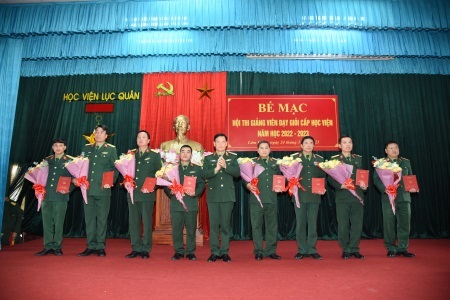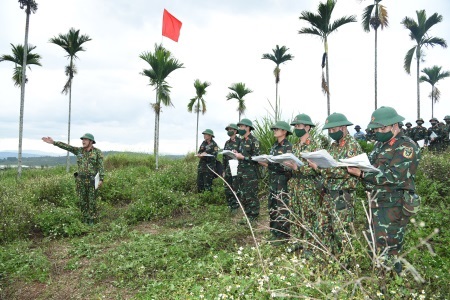Grasping Resolution No.1657 of the Central Military Commission, the Army Academy improves the quality of education and training towards standardisation and modernisation
Recognising the pivotal role of education and training in improving the quality of human resources to meet the requirements of building an adept, compact, strong, and modernised Military, the Army Academy Party Committee and Directorates have formulated numerous strategies and leadership solutions to direct breakthrough innovations in content and programmes in association with innovative teaching and learning methods, and the development of a contingent of instructors and educational management cadres. Thanks to high determination and practical, effective solutions, the quality of education and training at the Academy is progressively improving, ensuring substance and transparency. Graduates effectively apply the knowledge acquired at the Academy to leadership, management, and command tasks, enhancing the quality of training and combat readiness.
Currently, facing the increasing demands of the Military construction, national defence, and Fatherland protection, the education and training mission of the Academy continues to develop in terms of scope, quantity, and quality. This necessitates fundamental, comprehensive, and appropriate solutions. To improve the quality of training for cadets towards standardisation and modernisation, the Academy Party Committee and Directorates have focused on leading and directing agencies, departments, faculties, and cadet management divisions to grasp and strictly implement Resolution No.1657-NQ/QUTW, dated December 20th, 2022, of the Central Military Commission on education and training in the Military. They are concentrating on specific content and solutions as follows.
 |
| Mr. Gen. Do Minh Xuong awards outstanding teachers of the academy in the 2022-2023 academic year |
Firstly, to strengthen the leadership and direction of the Party committees and commanders at all levels in innovating and improving the quality of education and training. This is a fundamental and crucial solution that determines the quality of education and training at the Academy. Successfully implementing this solution not only ensures that the educational work of the Academy is heading in the right direction, consolidates intelligence and belief, and creates a comprehensive strength to overcome difficulties and challenges, but it also serves as a foundational element for the effective implementation of other solutions. Accordingly, the Party committees and commanders at all levels have regularly conducted in-depth research and closely followed the Party’s viewpoints and policies, State laws, resolutions, and directives of the Central Military Commission, the Ministry of National Defence, on education and training and Resolution No.569-NQ/ĐU, dated April 5th, 2023, of the Academy Party Committee on innovating education and training to meet the requirements and tasks in the new situation. Based on this, they have developed specific plans and action programmes, ensuring practicality and suitability to the characteristics of each agency and unit, to aim for a significant transformation in awareness, consciousness, and responsibility for participants in the education and training process. Guided by the goals, targets, requirements, and tasks of education and training, the Academy has focused on enhancing the effectiveness of ideological work, maintaining a strong political orientation for the cadres and instructors, especially those leading the innovation and improvement of the quality of education and training towards standardisation and modernisation. Simultaneously, it has concentrated on fostering and enhancing political integrity and revolutionary ethics for the instructors, educational management cadres, and cadets; staunchly fighting against conservative thinking, reluctance to innovate, mechanical adherence, or satisfaction with the status quo; and emphasising on strengthening leadership and direction in the inspection, examination, and supervision of agencies, departments, and cadet management divisions, especially those directly involved in carrying out the education and training mission. This ensures that the task is regularly, closely, scientifically, and directionally conducted, in line with the function, mission, and practical experience, following the motto “The training quality of the institutions is the combat readiness of the units”.
Secondly, to enhance the quality of advice from various agencies and standardise the contingent of instructors and educational management cadres. This solution is both foundational and provides a significant incentive, contributing to the construction of the Academy as a regular, modern, exemplary institution. Therefore, the Academy has focused on leading and directing the construction and stabilisation of the organisation, structure, functions, and tasks of each agency and unit according to the new organisational and staffing charts to ensure balance, coordination, and rationality, avoiding overlapping functions and tasks while improving the efficiency of activities. Departments, faculties, and divisions must have the capability to provide advice and propose leadership and direction measures to the Academy Party Committee and Directorates. Additionally, they have guided the effective implementation of education and training tasks; developed a system of leadership and direction documents to enhance the quality and efficiency of coordination and cooperation among agencies and units in implementing education and training tasks.
Building and developing the contingent of instructors and educational management cadres is a pivotal issue in improving the quality of education and training. Recognising this, the Academy has strengthened its guidance to proactively review and develop plans for the utilisation of this contingent, aligning them with the Scheme “Building a contingent of instructors and educational management cadres in the Military in the 2023 - 2030 period and beyond”; actively sourced, selected, and supplemented the instructors based on defined criteria, especially focusing on those with postgraduate qualifications; proactively innovated the content, methods, and forms of training and developing the contingent of instructors and educational management cadres towards comprehensive competence, emphasising the capabilities in programme development, modern teaching methods, scientific research, and the application of information technology in teaching activities; and sent instructors to work in units with appropriate training levels and corresponding positions to accumulate practical knowledge. Its goal is to have 75% of instructors and educational management cadres meeting standards by the end of 2025, with 100% having at least a bachelor degree, and 70% having postgraduate qualifications, with 25% or more holding a Ph.D.
 |
| Learners of the academy participate in the exercise |
Thirdly, to innovate and harmonise the content, programmes, and training processes and develop comprehensive outcome standards. Aligned with the viewpoints, goals, and requirements of education and training, the Academy has systematically reviewed and innovated content, programmes, and training processes, towards shortening theoretical learning time and increasing practical training, real-life learning, and self-study of cadets to ensure systematicity and coherence between different training levels. Based on framework programmes and the quality survey results of trained personnel working in various military agencies and units, the Academy has regularly drawn experience lessons after each training course; kept track of the quantity and quality of instructors, existing facilities, and investment direction for the upcoming years, using this information to adjust and supplement training programme content.
Following the Decision No.3061/QĐ-BQP, dated July 11th, 2023, of the Minister of National Defence approving the Scheme “Innovating the training processes and programmes for cadets at all levels in the Military to meet the requirements and tasks in the new situation”, the Academy has actively implemented the comprehensive construction and continuous improvement of 23 framework programmes and detailed programmes for each course in line with the fundamental and comprehensive innovation in content, meeting the training objectives and requirements for tactical and operational-level learners in the current and future periods. Simultaneously, it has focused on reviewing and removing duplicate content, and supplementing new knowledge into the training programme, based on the criteria of training what learners need to assume their duties after graduation. Alongside the innovation of content, programmes, and processes, the Academy has continued to perfect the development of outcome standards for training programmes, ensuring practicality and consistency with the training programmes’ objectives and alignment with the input standards of higher education levels, suitable for the training audience, responsibilities after graduation, practical training, combat readiness, and requirements for building the Military. There has also been a focus on building outcome standards for each course and lecture that fully reflect the content of the training programme outcomes and ensure a tight connection to enhance the quality of the training programme.
Fourthly, to focus on innovating methods of teaching, assessment, and evaluation of education and training results. Based on the defined objectives, requirements, and tasks of education and training, the Academy has actively researched and applied diverse and flexible positive teaching methods, closely tied to practicality, to leverage the learners’ initiative and creativity, aligning theory with practice; maintained quality teaching methodology activities while enhancing the training and self-training of the instructors; focused on improving moral qualities, pedagogical skills, language proficiency, and the ability to apply information technology and modern teaching tools in education and research; promoted and improved the quality of self-study and self-discipline of cadets towards transforming the training into self-directed training; instilled a passion for learning, scientific research, and continuous improvement; continued to guide agencies, departments, and cadet management system to effectively implement the “3 breakthroughs, 3 no’s, and 3 realities” and coordinated the evaluation of cadets’ learning outcomes; and strengthened inspection and examination, ensuring that the quality of education and training is objectively, substantially, and firmly evaluated.
Finally, to build a smart and modern Academy in association with digital transformation. This is a crucial solution for constructing a “Smart Academy, embracing the Fourth Industrial Revolution” aligned with the development of an e-Government towards a Digital Government in the Ministry of National Defence. Accordingly, the Academy has identified several key areas in building a smart and modern Academy, including the application of smart pedagogy and intelligent teaching; development of smart libraries, learning resource centres, smart classrooms, integrated smart campuses, electronic information portals, and software and information technology applications; investment in online and remote training on military data networks; and building the Tactic and strategic research Review that meets the standards of Vietnamese military science. To enhance the IT and language proficiency of cadres, instructors, and cadets, the Academy continues to invest in and upgrade information technology infrastructure, ensuring data connectivity to all agencies and units and security, safety, stability, fast transmission speed, contributing further to enhancing the quality of education and training in the direction of standardisation and modernisation, serving the modernisation process of the Military and the Fatherland protection cause.
Major General, Dr. DO MINH XUONG, Rector of the Academy